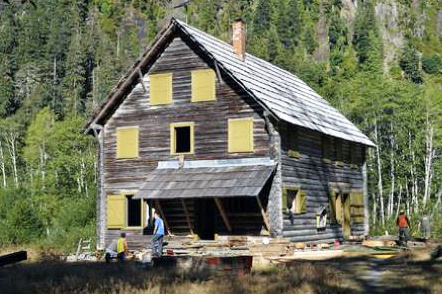If you’ve seen it for yourself, you’ll agree the Enchanted Valley Chalet is a magnificent structure sited in a valley so grand that Yosemite should be envious. The valley, now a designated wilderness area, is undeniably rich with human history and the crown in that story is the chalet. This grand old building is one of our Olympic National Park’s last and finest remaining structures dating to the days before the “park” was officially a National Park.
We now have the opportunity — no, the obligation — to write a new chapter in the long history of the Enchanted Valley Chalet. At eighty five years old, the nationally and internationally beloved building deserves to stand proud throughout the next century and beyond.
Our National Park Service is currently soliciting input on the future of this local historic treasure and the Polson Museum urges you to actively support the relocation of the chalet to a new stable and permanent location within the valley. The deadline to comment on this action is Aug. 31.
With the creation of Olympic National Park in 1938 and the National Park Service’s subsequent purchase of the Enchanted Valley Chalet in 1939, our federal government accepted responsibility of caring for this iconic structure. Much like Independence Hall in Philadelphia, Appomattox Court House in Virginia or the Cadillac Hotel in Seattle, the National Park Service actively preserves structures at National Historic Parks throughout the country. In this vein, we believe that the Enchanted Valley Chalet deserves to be saved by our National Park Service.
The chalet was built in 1931 by the Olson family of Quinault whose Olympic Recreation Company operated it as a destination lodge deep up the Quinault River Valley. Under the Olson’s ownership through the 1930s, and for decades under the National Park Service, the chalet has endured as a destination in its own right. The Olympians Hiking Club, founded in Hoquiam in 1915 and active to this day, played a crucial role in saving the chalet when the building was restored in the mid-1980s.
The chalet was listed on the National Register of Historic Places in 2007, and in 2014, the Park Service took emergency action to temporarily move it out of the path of the Quinault River which had undercut its foundation. Steel I-beams and other necessary equipment were brought in at that time and remain on site, greatly simplifying the building’s future move to a new permanent location.
Earlier this year the Park Service proposed three options for the chalet: 1) do nothing and let nature run its course; 2) place a foundation under the chalet in its current location and let nature run its course; 3) dismantle and remove the chalet. In early July at the urging of historic preservation minded individuals, the NPS added to this list the fourth option to relocate the chalet within the valley.
The Polson Museum asks you now to join in supporting the relocation of the chalet out of the floodplain beyond the reach of the Quinault River. To make this happen, the Park Service needs to hear from you in writing either online or by mail by the end of this month: http://parkplanning.nps.gov/EVCscoping; Superintendent Sarah Creachbaum: Olympic National Park – EVC Scoping, 600 East Park Ave., Port Angeles, WA 98362
Thank you in advance for doing your part to ensure that many more generations will have the opportunity to enjoy and experience this wilderness treasure!
John Larson is the director of the Polson Museum in Hoquiam.


